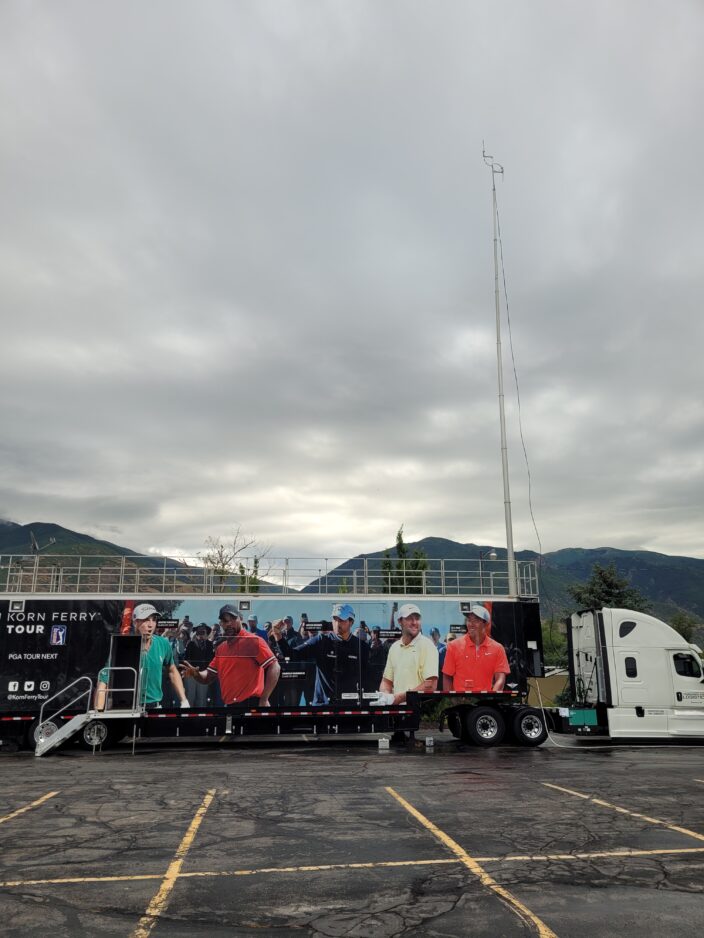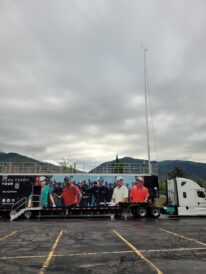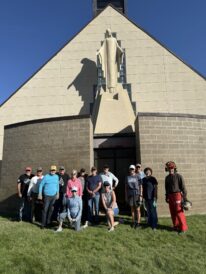Pro golf behind the scenes: What it takes to put on the Utah Championship
- A grandstand/skybox is set up behind the Utah Championship golf tournament’s 18th green at Oakridge Country Club in Farmington on Aug. 2, 2022.
- Utah Championship golf tournament director Jamie Stokes, right, prepares for a weather delay Friday, Aug. 5, 2022, at Oakridge Country Club in Farmington.
- A TV broadcast truck sits in the parking lot at Oakridge Country Club on Aug. 2, 2022. The truck helped to broadcast the Utah Championship golf tournament on Golf Channel last week.
- A grandstand/skybox is set up behind the Utah Championship golf tournament’s 18th green at Oakridge Country Club in Farmington on Aug. 2, 2022.
FARMINGTON — Every summer, golf fans show up to watch professional golf at Oakridge Country Club for the Korn Ferry Tour’s Utah Championship.
Anyone who’s been at the course before can walk around and see how it gets dressed up for the tournament.
Ropes and stakes line the fairways, the rough is thicker, the pin placements are tricky, canopy tents are all around the clubhouse, two TV towers are on the course and there’s a skybox seating area surrounding the 18th green.
Much goes into putting on the tournament that people don’t see, from weeks of setup and takedown, to food service, course maintenance and lots of hours behind the scenes.
FOOD AND BEVERAGE
Andrew Kozan, a 23-year-old Auburn University graduate, shot 8-under-par 63 on Sunday with five birdies on the back nine to finish 21-under overall and win the Utah Championship by one shot.
Tournament officials presented Kozan with the requisite large check for $135,000 on the 18th green.
Later, Kozan opened a can of Coors Banquet beer and drank it out of the winner’s trophy. He had missed 11 straight cuts on the KFT before winning in Farmington.
The other winner of the Utah Championship, however, might have been attendance and concessions. Oakridge general manager Mark Jensen estimated a record crowd about 4,000 fans on Sunday.
It helped that golfers with local ties, such as Patrick Fishburn and Zac Blair, were playing well.
“Honestly, when those players came through the 18th green, and the 18th fairway, and the 18th skybox suites, you honestly would’ve thought they’d won by the way the crowd reacted to them and by the way they made their putts,” Jensen said.
Attendance was up, meaning concession areas the course set up on the tournament’s 14th hole, as well as been the ninth and eighteenth holes, sold an “unbelievable” amount of food and drinks.
Jensen estimated 1,000-1,500 “meals” were sold through concessions and simple math puts the dollar figure from concessions alone at five figures, minimum.
The club’s primary responsibility is to set up a good golf course, Jensen said. A greenskeeping crew of about 20-25 workers takes care of that aspect.
The club’s next responsibility is food and beverage for the public, its VIPs and pretty much everyone else.
Meals are served to players, caddies, volunteers, club staff, PGA Tour staff, tournament workers and basically anyone who has a hand in putting on the tournament.
Starting on Monday, when the club hosted the Tony Finau golf clinic and charity tournament, through Sunday’s final round, about 4,500 meals were served, Jensen said.
Players, staff, volunteers and caddies eat in different rooms of the clubhouse. The banquet room on the south side serves volunteers and caddies breakfast, lunch, drinks any time of day and a coffee from a pot that, this year, leaked and dyed a white tablecloth brown.
This room is also where a tournament worker trained walking scorer volunteers on how to use shot tracking software that shows up on the PGA’s live leaderboard.
Every year, though, the winner in the volunteer dining room is mayonnaise packets. Piles of sandwiches are available for lunch and most years, someone has to ask kitchen staff to refill the basket of mayo packets.
Even more often, someone has to ask kitchen staff to refill the coffee, as out-of-staters tend to drink more coffee than Utahns do.
SETUP, TAKEDOWN AND PIVOTING
Clouds cast an ominous look on Friday afternoon. It’s why tournament director Jamie Stokes was half in and out of a golf cart near the driving range.
It’s why several other carts were lined up nearby with people in the driver’s seat of each one.
The horn blew at 3:13 p.m. signaling play had been suspended.
“Go, go, go!” Stokes said to the cart drivers, instructing them to go to the south side of the course.
“Listen to me, players and caddies only!” he yelled.
This year’s tournament brought the first rain delay to the Utah Championship since it came to Oakridge five years ago. It also brought the second and the third rain delays.
“Nothing ever goes like you want it to, so you have to be prepared to pivot,” he said.
Stokes, a Tennessee resident with a discernible Southern accent, contracts with the Utah Sports Commission to run the tournament.
The Commission is the host organization that manages the event, Commission president Jeff Robbins said, and does its heavy lifting with getting volunteers to work the tournament and putting on the pro-ams on Wednesday.
Essentially, if the tournament does or doesn’t go well, it makes its way back to the Commission.
Stokes is one of the first to get here, right around the time a couple weeks ago that fiber optic internet got set up, and is one of the last to leave.
Stokes secures logistical things for the tournament, including contracts with companies that set up and tear down the temporary structures.
Some vendors are Utah companies like Diamond Rental (canopy tents) and Fusion Imaging (printing services), and others are national companies like InProduction (TV towers and skybox).
Overall, there’s just a lot of stuff on and around the course.
There are copious amounts of signage, tents, portable restrooms, trash cans, tables, chairs, ropes and stakes to keep fans off the course, and generators to power the on-course scoreboards the PGA Tour hauls to tournaments.
Stokes said a tournament like this isn’t possible without people power. There are about 250-300 volunteers that help during the event, Stokes said.
They do just about anything, from holding the “Quiet Please” signs when a player’s ready to hit the ball, to stopping traffic on Shepard Lane so players can cross the street.
“There’s probably 20 areas of just volunteering,” Stokes said.
There are about two dozen different radio channels in use from security, to live-scoring, to tournament operations and the TV broadcast.
This year’s tournament was broadcast on the Golf Channel in a scaled-down version compared to prior years.
Several large trucks — one of them had a huge satellite dish — used to park inside the fence north of Shepard Lane. Miles of cable used to wind through the course and at least two mobile hydraulic lift platforms (think scissor lifts but outfitted with off-road tires) roamed the ninth and 18th holes.
Now, the TV broadcast comes from a 60-foot semi-trailer in the parking lot, the two TV towers and an armada of about 25-30 golf carts.
Most everything else is shot by videographers who drive around on the carts and wirelessly transmit their footage to the broadcast truck, which transmits it to the Golf Channel in Florida.
Some broadcast talent is physically on site and others aren’t. Often, it’s hard to tell the broadcasters are in a studio two time zones away as they accurately describe Ogden native Fishburn’s pro golfer journey to date.
Other times, the broadcast shows B-roll footage of what it calls the “nearby” Zion National Park, or refers to Kozan’s wife as his mother.
Similarly, the PGA used to send more than a dozen communications and digital media workers to the Utah Championship to cover the tournament for the PGA website, assist on-site media, shoot and edit highlights, and
This year there weren’t as many digital media workers with the PGA which, like a lot of companies, has gone for the cost-savings and remote work route.
Still, the clubhouse is buzzing starting on about Monday or Tuesday of tournament week and doesn’t stop until the next Monday.
GOLF AND GRASS
Then, there’s the actual golf portion of the tournament. The field starts at 156 players and whittles down to half that size by the weekend.
The golfers, who are subject to PED testing held in one of the locker rooms, come from all over the country and sometimes the world. From 300 yards away, they look exactly the same.
Golf tournaments smell like a lot of things: grass, sweat, sunscreen, treated water, exhaust fumes from the generators, cigar smoke, beer and cologne.
The sound of a pro golfer hitting a ball is a little more violent than the sound a common golfer makes. This is professional golf, where a 300-yard drive down the middle of a fairway sometimes elicits an audible curse word because the standards are just that high.
As the old PGA Tour television ad used to say, these guys are good. One volunteer joked that pro golfers come from the fictional planet of Krypton where Superman was born.
As for the course, there are three main differences between the tournament setup and the everyday setup. The first is the front and back nines are switched, it’s a Par 71 instead of Par 72, and the rough is longer (2 1/2 inches instead of just under 2 inches).
Three years ago, this tournament was in June. Now, it’s in August.
“It’s mostly the nighttime temperatures, when it doesn’t cool down, our cool-season grass, if they’re going to struggle, that’s when they’re going to struggle,” course superintendent Wes York said.
In spite of the record-hot July, Oakridge was green last week just as it has been. A few spots are dry and brown, but they’re few and far between.
York said a new, high-tech irrigation system installed between 2018 and 2019 has helped the crew water more efficiently, a particularly helpful aspect given Utah’s drought.
The grounds crew is at the course at 4:30 a.m. and then comes back after the rounds are done during the tournament week to make sure the course is holding up to hundreds of pros slicing and carving it up.
NONSTOP
The week begins with the Tony Finau charity golf tournament on Monday. Tuesday brings practice rounds, Wednesday has two pro-ams.
Then Thursday starts the tournament, the PGA Tour takes over and for four days, golf balls rattle the bottom of the cup and a champion is crowned. John Daly won this tournament in 1990.
Less than 24 hours after Kozan drank beer from the Utah Championship trophy, some things from the Korn Ferry Tour’s traveling circus were gone and some remained. Oakridge was quiet.
Various trucks came and went picking up rented supplies, but the 18th-hole skybox was still there along with the canopy tents.
Jensen is a one-man band, running around doing various things during the tournament and normally sleeps four hours per night during tournament week. Hardly anyone sleeps during the tournament and most people work a ton of hours to help it run smoothly.
Planning for the 2023 tournament has already started. Stokes said planning for future tournaments and evaluating the past ones never really stops.
The contract between the PGA Tour and the Utah Sports Commission has the tournament coming back to Farmington in 2023 with an option for 2024.
The PGA has to want the tournament in Utah, the Commission has to want to host the tournament and has to want it at Oakridge.
It’s been here six times now, so something’s apparently going well.
Connect with reporter Patrick Carr via email at pcarr@standard.net, Twitter @patrickcarr_ and Instagram @standardexaminersports.











